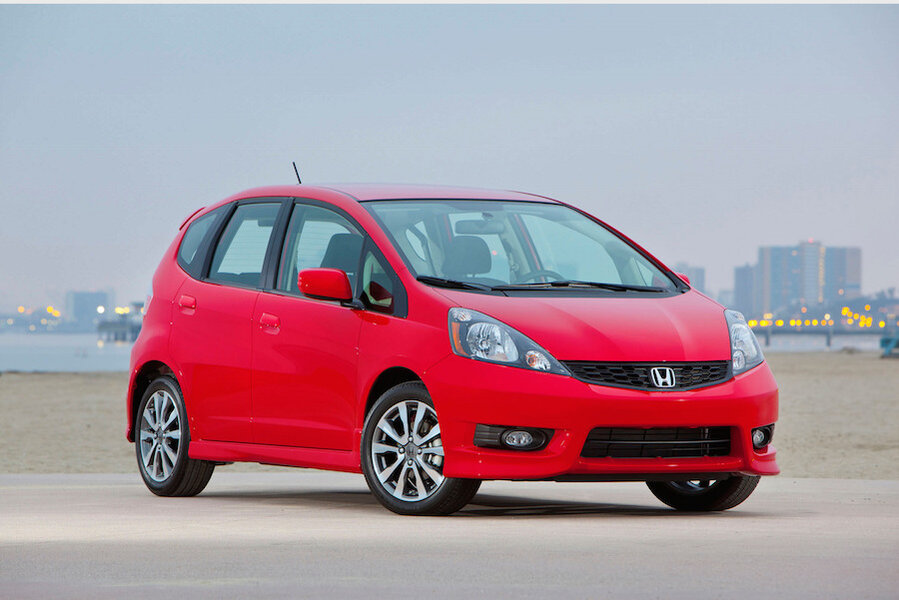Honda Fit vs. Hyundai Accent: Which economy car fits you best?
Loading...
Both the Honda Fit and the Hyundai Accent are economy cars, but each has some distinct appeal for buyers. The question is--which one fits you best?
We rate one of them higher by a wide margin, but before we divulge the winner, some basics. Both are sold as hatchbacks, but the Fit doesn't also offer a sedan model--which the Accent does. The Fit was entirely redesigned for 2015, while the Accent has remained pretty much unchanged since its launch as a 2012 model.
In hatchback form, the Fit and the Accent are both tall five-door cars with body creases and other design tricks to hide their boxy, almost wagon-like shapes. The fresher Honda is more distinctive, whereas the Accent comes across as almost the generic small car. Inside, the Honda offers more equipment features and options, but both have interiors with respectable materials that are pleasant enough, if distinctively non-luxury.
The Honda's front seats are particularly comfortable for a car this size, and the Fit is capable of holding four adults in its surprisingly roomy passenger space. The Accent is a little less good on long trips, but the real win for Honda is the aptly-named "Magic Seat" arrangement. The rear seats fold and flip to create a cargo area from the floor to the roof, while the front seats recline fully to create an almost-flat upholstered interior platform. The result is unparalleled flexibility that holds remarkable numbers of people and volumes of cargo. The littlest Honda wins hands-down for interior adaptability not only over the Accent, but over any other entry in its segment--and even a few larger compact cars to boot. The rear seats of both the hatchback and sedan Accents fold, but that's about it.
The Accent is powered by a 138-horsepower, 1.6-liter four-cylinder engine, which matches best with the base six-speed manual gearbox and its light clutch. Equipped with the more common six-speed automatic transmission, it takes the Accent about 10 seconds to accelerate from zero to 60 miles per hour, which is slow. The automatic does offer a Sport mode and manual control, but to get the most out of its engine, it has to be revved high, above 3500 rpm. Even so, it's taxed with more than two people aboard. Gas mileage is either 30 mpg combined with the automatic or 31 mpg combined with the six-speed manual.
Similarly, the Honda Fit uses a 130-horsepower 1.5-liter four-cylinder engine with a six-speed manual gearbox as standard. However, most Fits will use a continuously-variable transmission (CVT) that does far better on fuel efficiencythan any Accent. The combined EPA rating of 36 mpg (33 mpg city, 41 highway) vaults Honda to the head of its class for EPA ratings. It's done a decent job of making the CVT tolerable, and the Fit suppresses most exterior noise fairly well even at speeds well above any U.S. speed limit.
The 2016 Honda Fit has earned very good safety scores from both the Insurance Institute for Highway Safety (IIHS), which dubs it a Top Safety Pick, and the National Highway Traffic Safety Administration (NHTSA). The NHTSA gives it five stars overall, and the Fit achieved Good ratings in all IIHS categories except the tough new small-overlap front crash tests, where it was rated Acceptable. The Accent, on the other hand, doesn't rate very well with the NHTSA or the IIHS. It scores four stars with the federal government, which also adds some extra notes about concerns over its performance in side crashes. In IIHS testing, the Accent receives a score of Poor on the small-overlap test.
The 2016 Honda Fit encompasses four models and primary builds: a base Fit LX, a mid-range EX, and a premium EX-L. Keyless entry, cruise control, a rearview camera, and air conditioning are among many items now included even on the base LX, while mid-level EX models get push-button start, upgraded infotainment, and Honda's impressive LaneWatch wide-angle lane-change aid from the Accord. The Fit EX-L heaps on leather and more luxury, while its top-of-the-line EX-L With Navigation trim level gets a high-contrast system with live traffic data that's finally worth the premium.
The 2016 Accent is simpler, with just two trim levels: the standard Accent SE in hatchback and sedan versions, and the Accent Sport, which comes only as a hatch. Accents come with a decent level of standard equipment, but don't look for leather, a sunroof, or navigation on the options list. Base versions get power windows, locks, and mirrors, along with air conditioning, while better-equipped models add a tilt/telescoping wheel, cruise control, satellite radio, and Bluetooth pairing.
In the end, the Honda Fit gets a decisive nod over the Hyundai Accent, with a score of 8.2 out of 10 versus the Accent's 6.6. The unparalleled flexibility of Honda's interior isn't remotely matched by the conventional Accent, and the Fit also wins on safety, on a wider range of features and options, and a less strained driving feel with an automatic transmission.







